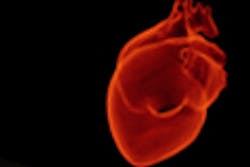Use of high-sensitivity troponin T is associated with fewer adverse events in patients with chest pain
Chest pain is one of the most common reasons why people seek emergency care at the hospital, and it is one of the main signs of acute coronary syndrome (ACS). The investigation of these patients usually includes a clinical examination, ECG, and blood sampling for analysis of the cardiac biomarker troponin. ACS is ruled out in most patients, who are then discharged with the diagnosis ”unspecified chest pain.”
In a 2016 study by Omstedt et al, it was found that approximately one percent of these discharged patients experienced a major adverse cardiac event (MACE) within the next 30 days.1 Since the introduction of troponin as a biomarker for cardiac injury, the sensitivity of the assays has improved and their use has been more widespread. In recent years, the fifth-generation assay high sensitivity troponin T (hsTnT), has been widely implemented in hospitals in our native Sweden and elsewhere. There were no previous studies regarding the incidence of MACE in relation to the clinical use of this high-sensitivity assay in patients with unspecified chest pain.
Study methodology
We therefore conducted a registry-based cohort study of 65,696 patients,2 all 18 years and older, who were discharged with ”unspecified chest pain” (defined as code R07.1-4 per the International Classification of Diseases-10th edition) between July 2006 and November 2013, to investigate whether the implementation of hsTnT assays in Swedish hospitals resulted in reduced incidence of MACE in this patient group. MACE was defined as a hospital stay with myocardial infarction (MI), unplanned revascularization, or all-cause mortality. Patients evaluated with the conventional assay were compared with patients evaluated with the new hsTnT assay. Patients were divided into two groups: those who were discharged directly from the emergency department (ED), and those who were discharged after an initial admission within the ED.
The hsTnT assay implemented in 16 Swedish hospitals was the current iteration of the cTnT assay. This new biomarker was compared to ”conventional” assays.
Results and discussion
The majority of patients (57,701; 88 percent) were discharged directly from the ED, while the rest were discharged after an initial admission. When conventional assays were in use, cardiovascular risk factors and history of cardiovascular disease were more common in patients who were directly discharged. In directly discharged patients, 270 patients (0.9 percent) had a MACE within 30 days when conventional assays were in use compared to 185 patients (0.6 percent), analyzed with hsTnT (p < 0.001) (odds ratio: 0.7, 95 percent; confidence interval: 0.57 to 0.83). More of the admitted patients had a cardiovascular high- risk profile after the implementation of hsTnT. For these admitted patients, 199 (3.4 percent) experienced a MACE within 30 days with conventional assays, and 157 patients (7.2 percent) after the introduction of the hsTnT assay (p < 0.001). In contrast to the directly discharged patients, there was a significant increase in the number of MACE events after the introduction of hsTnT (odds ratio: 2.18, 95 percent; confidence interval: 1.76 to 2.72) among admitted patients.
Our study showed that patients with chest pain directly discharged from the ED had fewer MACEs and significantly less cardiovascular disease and risk factors after the implementation of a high-sensitivity troponin assay, as opposed to patients analyzed with the conventional assays. However, patients discharged after an initial admission had a significantly higher incidence of MACE and more cardiovascular risk factors when analyzed with the newer, hsTnT assay. Previous studies regarding assays with higher sensitivity have shown that more at-risk patients are admitted, and they also report a significant increase in admitted ACS patients with troponin levels above the myocardial infarction (MI) cut-off.3 Other studies have also shown that in patients with baseline hsTnT elevation with a negative conventional assay, there was an incremental increase in nonfatal MI or death. We believe that this newer assay has detected more true at-risk patients in our study compared to the conventional assays, which would explain why the admitted patients had a higher incidence of MACE and a higher cardiovascular risk profile. We believe that our study reflects clinical reality, since it is performed on unselected patients who were healthy or with previous ACS.
Clinical implications
The implementation of the hsTnT assay in Swedish hospitals was associated with fewer MACEs in patients with unspecified chest pain who were directly discharged from the ED. The opposite was observed for admitted patients. We believe that more true at-risk patients were identified and admitted with the newer assay and that it appears to have improved evaluations in the ED. Further, the hsTnT assay provides an opportunity to employ a one-hour algorithm in the ED, which uses the one-hour delta value of troponin T that has been introduced recently in some Swedish hospitals. Although these algorithms were not investigated in our study, they may provide an even quicker and safer rule-out of ACS in the ED.
REFERENCES
- Omstedt A, Hoijer J, Djarv T, Svensson P. Hypertension predicts major adverse cardiac events after discharge from the emergency department with unspecified chest pain. Euro heart J Acute Cardiovasc Care. 2016;5(5):441-448.
- Nejatian A, Omstedt A, Hoijer J, Hansson LO, Djarv T, Eggers KM, Svensson P. Outcomes in patients with chest pain discharged after evaluation using a high-sensitivity troponin T assay. J Am Coll Cardiol. 2017;69(21):2622-2630.
- Eggers KM, Lindahl B, Melki D, Jernberg T. Consequences of implementing a cardiac troponin assay with improved sensitivity at Swedish coronary care units: an analysis from the SWEDEHEART registry. Euro heart journal. 2016;37(30):2417-2424.
Atosa Nejatian, MD, and Åsa Omstedt, MD, are physicians at Karolinska University Hospital, Stockholm, Sweden. Per Svensson, MD, PhD, serves as a senior lecturer at Karolinska Institute.

